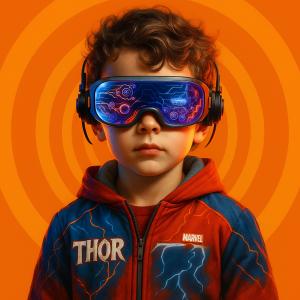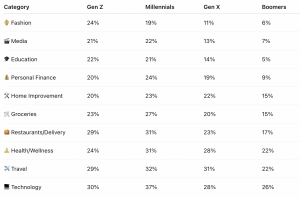What Gen Alpha Is Teaching Us About AI, Trust, and the Future of Brand Relationships

A new generation is emerging—one that doesn’t just use technology, but builds relationships with it. What Gen Alpha is teaching us about AI, trust, and branding.
Brand strategist Luca Bertocci explores how Gen Alpha is reshaping AI, friction, and trust—and credits key voices driving the conversation forward.
Titled “When Technology Becomes a Relationship: What Gen Alpha Is Teaching Us About AI and the Future of Marketing,” the piece explores the implications of AI as a relational presence rather than a functional tool. It combines cultural insight, real-time experimentation, and consumer data to examine how brands must evolve in an age of emotionally intelligent technology.
The article draws on recent thinking by Abby Ho (Fellow Kids newsletter), Sara Wilson (SW Projects), and Kyla Scanlon (creator and economic analyst), continuing a growing dialogue about AI’s cultural and behavioral impact. It is published by Human Centric Group, a London-based strategy consultancy known for its human-centered approach to branding and innovation.
From Family Moment to Market Signal
The article centers on a simple experiment: using ChatGPT’s voice and video mode to interact with two young children in English, Italian, and Polish. What emerges is more than a test of AI capabilities. It’s a glimpse into how younger generations intuitively treat technology as a companion, not just a command center.
The child–AI interaction revealed fluid language switching, curiosity-driven questioning, and emotional engagement, especially in English. In other languages, technical accuracy remained, but emotional warmth fell short.
These early behaviors, the article suggests, offer a preview of future consumer expectations: frictionless design, adaptive tone, and presence over performance.
“This isn’t about voice mode as a feature. It’s about AI as a presence,” the article notes. “Marketing is shifting from campaign-driven to companion-driven.”
Rethinking Friction, Trust, and Taste
Through the lens of Gen Alpha and insights from leading thinkers, the article identifies three cultural forces shaping AI engagement:
• Frictionless digital systems engineered by platforms
• Eroding physical systems that drive disillusionment
• Curated luxury environments where friction is a status symbol
As Abby Ho wrote, “friction is now a luxury; taste is a survival skill.” In this context, the article argues that brands must become curators of trust—offering emotionally intelligent, culturally fluent, and context-aware experiences.
Insights Backed by Consumer Data
To support its argument, the article integrates fresh analysis from Human Centric Group’s elaboration of GWI Zeitgeist data (June 2025), covering the UK and U.S. markets. The findings confirm that:
• Gen Z shows the highest interest in AI support for identity-driven needs like fashion and education
• Millennials lead in practical areas like tech and wellness
• Boomers remain more reserved, especially in categories tied to personal finance and food
These trends suggest that brands must not only segment by generation—but design for emotional mindset, context, and trust.
Context for Brand and Innovation Leaders
The article contributes to a fast-developing conversation about how AI is reshaping the way consumers interact with technology, brands, and each other. It emphasizes the need for brands to move beyond efficiency and personalization toward adaptive presence, where content is not just delivered, but felt.
It is available in full at Human Centric Group blog.
About the author
Luca Bertocci is a co-founder and co-owner of Human Centric Group, where he partners with boards, founders, and C-level executives to transform brands into strategic business assets. He leads the agency’s analytical department, applying a data-driven approach to unlock sustainable, long-term value for global clients such as Carlsberg, PepsiCo, Danone, Mitsubishi Electric, and Carrefour, across more than 30 countries.
Before Human Centric Group, Luca was an equity partner at Garrison Group and held key roles at Pirelli Tyres and Desk Promos (special agency of the Italian Chamber of Commerce) during Expo Shanghai 2010.
Beyond consulting, Luca is a lecturer at Krakow School of Business (International MBA), and AGH Business School (EMBA and Tech MBA). He also serves as a mentor for Bocconi University and for several startups in Poland, combining entrepreneurial spirit with academic rigor.
Media Enquiries
HUMAN CENTRIC GROUP LTD
+44 20 3693 4480
community|humancg.com| |community|humancg.com
Visit us on social media:
LinkedIn
Instagram
TikTok
X
Legal Disclaimer:
EIN Presswire provides this news content "as is" without warranty of any kind. We do not accept any responsibility or liability for the accuracy, content, images, videos, licenses, completeness, legality, or reliability of the information contained in this article. If you have any complaints or copyright issues related to this article, kindly contact the author above.
Hannox Launches Advanced Hydrogel Dressing for Safer, Faster Wound Healing
Bidding Set to Close on 4BR/2BA Home on 3.8± Acres in Spotsylvania County VA Announces Nicholls Auction Marketing Group
IoT Microcontroller Market to Rise at CAGR of 14.2% to Reach US$ 27,405 Million by 2035: Fact.MR Study
Więcej ważnych informacji
 Jedynka Newserii
Jedynka Newserii

 Jedynka Newserii
Jedynka Newserii

Polityka

Unijne mechanizmy ułatwiają zwiększenie wydatków na obronność przez europejskie kraje NATO. Ważnym aspektem infrastruktura podwójnego zastosowania
Wydatki na obronność w krajach NATO mają wzrosnąć do 2035 roku do 5 proc. PKB. W dużej mierze będzie to możliwe dzięki Unii Europejskiej, która stworzyła ramy umożliwiające krajom członkowskim realizację celów NATO w zakresie obronności, nie tylko poprzez finansowanie i inwestycje, ale także poprzez elastyczność budżetową. – To pełna synergia, można powiedzieć, że Unia Europejska współfinansuje razem z państwami członkowskimi cele zdolnościowe NATO – ocenia Paweł Zalewski, sekretarz stanu w Ministerstwie Obrony Narodowej.
Ochrona środowiska
Rusza budowa lądowej infrastruktury dla projektów Bałtyk 2 i Bałtyk 3. Prąd z tych farm wiatrowych popłynie w 2027 roku

Ruszyła budowa lądowej infrastruktury dla morskich farm wiatrowych Bałtyk 2 i Bałtyk 3 rozwijanych przez Equinor i Grupę Polenergia. To przede wszystkim baza serwisowa w Łebie i dwie stacje elektroenergetyczne. Jednocześnie trwają przygotowania do rozpoczęcia prac na morzu. Pierwszy prąd z obu projektów popłynie w 2027 roku, a w kolejce czeka morska farma wiatrowa Bałtyk 1 – największy i najbardziej zaawansowany projekt II fazy rozwoju offshore.
Edukacja
Uczelnie zaczynają wspólnie walczyć ze zjawiskiem mobbingu i dyskryminacji. Ruszają badania nad skalą problemu

Szkoły wyższe chcą aktywniej walczyć ze zjawiskiem mobbingu i dyskryminacji zarówno wobec pracowników, jak i studentów. W ramach projektu Bezpieczna Uczelnia będą się wymieniać dobrymi praktykami w zakresie polityki antymobbingowej. Zostaną przeprowadzone także badania na temat obecnej sytuacji w środowisku akademickim. Dotychczasowe badania prowadzone przez Fundację Science Watch Polska wskazują, że mobbing to dość powszechne zjawisko na uczelniach, które przybiera charakterystyczne dla środowiska formy.
Partner serwisu
Szkolenia

Akademia Newserii
Akademia Newserii to projekt, w ramach którego najlepsi polscy dziennikarze biznesowi, giełdowi oraz lifestylowi, a także szkoleniowcy z wieloletnim doświadczeniem dzielą się swoją wiedzą nt. pracy z mediami.









.gif)

 |
| |
| |
|